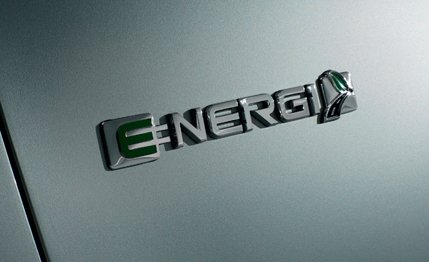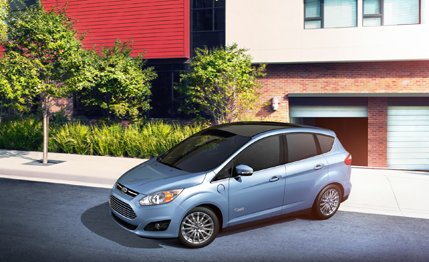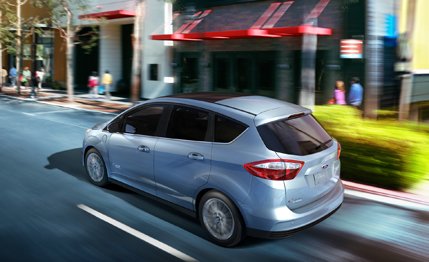
 First Drive Review
First Drive Review
Ford recently introduced the five-seat C-Max to America; in a nutshell, it’s a Focus platform–based, high-roofed wagon. But whereas the European C-Max is available with conventional drivetrains—and seven seats—the U.S.-spec version follows the Toyota Prius’s script in being all-hybrid, all the time. That makes it Ford’s first dedicated hybrid model for our market, a move the company hopes will give the little vanlet added visibility among environmentally sensitive shoppers.
In early 2013, Ford will start offering Americans a second variant of the C-Max, the plug-in hybrid Energi, which we recently sampled. It uses essentially the same powertrain as the hybrid—an efficient 148-hp, Atkinson-cycle 2.0-liter four-cylinder gasoline engine coupled to a 118-hp electric motor through Ford’s own HF35 eCVT Powersplit transaxle. The combined peak output is 188 hp, considerably more than either the Chevrolet Volt or the Toyota Prius plug-in hybrid, the two other affordable plug-ins currently on the market. (Wall-chargeable versions of the Honda Accord and Ford Fusion will be available soon.)
The key enhancement that turns a C-Max hybrid into an Energi is a much larger lithium-ion battery pack under the floor of the luggage area. With a capacity of 7.6 kWh, the Energi’s battery can propel the car for the first 21 miles of a journey on electric power, according to the EPA tests. When that battery is depleted, the gasoline engine fires up and the Energi runs just like the hybrid, using the combination of the gasoline engine and the electric motor to achieve an EPA combined mpg of 43. City mileage is pegged at 44 mpg, highway at 41.
Creating the Energi required more than more cells, though. There’s also a shorter final drive ratio for improved acceleration, a big deal because, in electric mode, the Energi is down 70 hp. Beefed up cooling for the electric motor and control electronics helps keep those items from overheating during sustained use.


We started our daylong test drive in and around San Francisco with a fully charged battery, although the instrument-panel readout only showed a range of 18 miles. After about 20 minutes of loading and unloading gear with the lights on, that figure fell to 14 miles, but during our short, electron-fueled run, the electric motor’s instant response made it very easy to squirt through city traffic. The steep hills in San Francisco posed no challenge for the Energi’s electric powertrain.
On the highway, however, the 118-hp electric motor was breathing hard. While it could sustain 75 mph—top speed in electric mode is listed as 85 mph—flooring the “gas” pedal above 70 mph gave only basically no indication of acceleration; we had to look at the speedometer needle to verify that we were, in fact, gaining speed.
We killed the battery after 11 miles, at which point the gasoline engine fired up automatically and completely imperceptibly. With all 188 ponies available, the C-Max Energi’s highway behavior becomes somewhat normal, and it fairly quickly topped 90 mph. In doing so, however, the CVT revs the gasoline over 5000 rpm and delivers the familiar constant and somewhat annoying drone.
Like nearly all current-generation Fords, the C-Max is very nice to drive. The body structure is tight and solid; the suspension has a European, well-damped feel; and the steering is accurate and nicely weighted, although without much feel in this case.


Hustling along a back road is fun until you reach seven-tenths—enthusiast-speak for the point where most people start to grow uncomfortable. Go beyond that and approach the car’s limits, and the estimated 3900-pound curb weight, the low-rolling resistance tires, and the high center of gravity make their presence felt. Confidently easing the car into corners isn’t helped by a brake pedal that feels synthetic in the first quarter of its travel—a not-unusual trait in blended regenerative and friction systems such as the one found in the Energi. The CVT isn’t the driver’s friend on winding roads either, as the transmission is always out of step with what you’re asking it to do.
Now, let’s go back to the peaceful reality where 99.9 percent of Energi buyers live. Most of those folks won’t be searching for sports-car roads to conquer in the C-Max Energi. The car is a highly practical urban people mover that packs a huge amount of space within its 173.6-inch length. Thanks to the tall roof and upright seating positions, four six-footers will fit in the C-Max without banging their heads or knees. And even with the load floor raised about eight inches to accommodate the large battery, the Energi has 19 cubic feet of luggage space, rising to 43 with the rear seat folded.
Compared with the Volt and the Prius plug-in—both of which are about three inches longer than the C-Max—the Ford is roomier in the front, and much more spacious in the back. Also, it has almost double the luggage space of the Volt, although a little less than the Prius.


Priced at $29,995 after a $3750 federal electric-car tax credit, the C-Max also delivers good value, undercutting the Volt by some $2500. Of course, the Volt does offer 38 miles of electric-only driving range—almost double the C-Max Energi’s. The Energi’s EPA-estimated 620-mile driving range between gas fill-ups is another point in its favor, though. And compared with the Prius plug-in, the C-Max nearly doubles the Toyota’s 11-mile electric range, costs $265 less, and can exceed the Toyota’s 62-mph pure-electric top speed.
Ford believes that these qualities put the C-max Energi in the sweet spot of the plug-in hybrid market. We’re inclined to agree, although the car’s biggest competitor might just be the regular-ol’ non-plug-in C-Max hybrid, which is cheaper by about four grand when taking the credit into account, has 25 percent more luggage space, and is rated for 47 mpg. Whichever option they choose, though, C-Max buyers shouldn’t be disappointed.